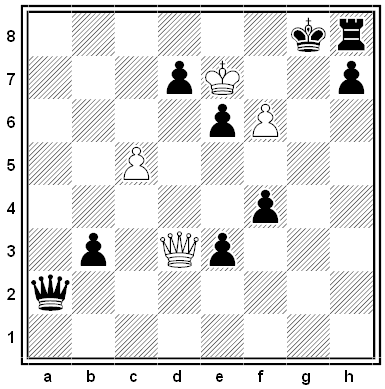Author: Greg Ross
Dog Tired

Maybe figures can’t lie, but liars can certainly figure, and that is why statistics can be made to ‘prove’ almost anything. Consider a group of ten girls, nine of them virgins, one pregnant. On the ‘average’ each of the nine virgins is ten per cent pregnant, while the girl who is about to have a baby is ninety per cent a virgin. Or, assuming that a fox terrier two feet long, with a tail an inch and a half high, can dig a hole three feet deep in ten minutes, to dig the Panama Canal in a single year would require only one fox terrier fifteen miles long, with a tail a mile and a half high.
— Stuart Cloete, The Third Way, 1947
Homework
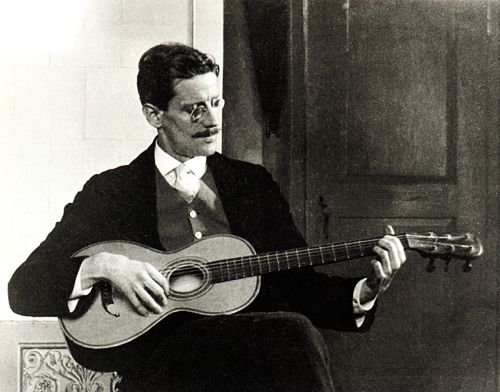
James Joyce took extraordinary pains in composing Ulysses. By his estimate the book cost him 20,000 hours of labor over eight years, and he told a friend that the resulting research “filled a small valise.” On Nov. 2, 1921, just weeks before the novel went to press, he wrote to his aunt, Josephine Murray:
Is it possible for an ordinary person to climb over the area railings of no 7 Eccles street, either from the path or the steps, lower himself from the lowest part of the railings till his feet are within 2 feet or 3 of the ground and drop unhurt. I saw it done myself but by a man of rather athletic build. I require this information in detail in order to determine the wording of a paragraph.
Sure enough, this passage appears in “Ithaca,” the book’s 17th episode, when Leopold Bloom realizes he has forgotten his key:
A stratagem. Resting his feet on the dwarf wall, he climbed over the area railings, compressed his hat on his head, grasped two points at the lower union of rails and stiles, lowered his body gradually by its length of five feet nine inches and a half to within two feet ten inches of the area pavement, and allowed his body to move freely in space by separating himself from the railings and crouching in preparation for the impact of the fall.
But time was always pressing. On Oct. 12 he begged Josephine for her recollections of some Dublin acquaintances: “Get an ordinary sheet of foolscap and a pencil,” he wrote, “and scribble any God damn drivel you may remember about these people.”
In a Word
manzil
n. the distance between two stopping places
Another puzzle by Sam Loyd: Two ferry boats ply the same route between ports on opposite sides of a river. They set out simultaneously from opposite ports, but one is faster than the other, so they meet at a point 720 yards from the nearest shore. When each boat reaches its destination, it waits 10 minutes to change passengers, then begins its return trip. Now the boats meet at a point 400 yards from the other shore. How wide is the river?
“The problem shows how the average person, who follows the cut-and-dried rules of mathematics, will be puzzled by a simple problem that requires only a slight knowledge of elementary arithmetic. It can be explained to a child, yet I hazard the opinion that ninety-nine out of every hundred of our shrewdest businessmen would fail to solve it in a week. So much for learning mathematics by rule instead of common sense which teaches the reason why!”
Sub Zapper
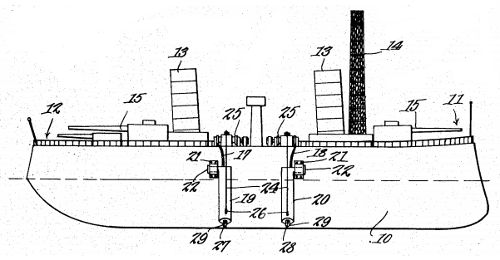
Here’s a simple way to deal with enemy submarines — hang giant electromagnets over the sides of your ship:
The magnets being projected outwardly from the ship’s sides, a submarine within the fields of the magnets is attracted and drawn thereto until the glass caps are struck by the submarine and broken. The contacts will now be against the submarine which will close the circuit through the submarine, lighting the lamp and ringing the signal bell, thus notifying the crew of the ship of the capture of the submarine. The submarine will also be electrified, shocking the crew thereof and killing or rendering them temporarily helpless.
Inventor Louis Schramm offered the scheme in 1914. I don’t know whether anyone tried it out. Let’s hope not.
Roy, Am I Mayor?
Palindromes:
- Sue, dice, do, to decide us.
- Do Good’s deeds live on? No, Evil’s deeds do, O God.
- Marge let a moody baby doom a telegram.
- No, it can assess an action.
- Poor Dan is in a droop.
- Repel evil as a live leper.
- See few owe fees.
- Niagara, O roar again!
- No, set a maple here, help a mate, son.
- Too far, Edna, we wander afoot.
- “Reviled did I live,” said I, “as evil I did deliver.”
- No, it is opposition.
- Revered now, I live on. O, did I do no evil, I wonder, ever?
- Madame, not one man is selfless; I name not one, madam.
- Draw no dray a yard onward.
- Yawn a more Roman way.
- Doom an evil deed, liven a mood.
- See, slave, I demonstrate yet arts no medieval sees.
J.A. Lindon devised this vignette, which is one long palindrome if words, rather than letters, are taken as the unit: “On radios with noisy speakers everywhere glass and china rattles; waiters, many of one race, move forks and knives, while knives and forks move, race; one of many waiters rattles china and glass, everywhere speakers noisy, with radios on …”
Humility
From a letter from Benjamin Franklin to Samuel Mather, May 12, 1784:
You mention your being in your seventy-eighth year; I am in my seventy-ninth; we are grown old together. It is now more than sixty years since I left Boston, but I remember well both your father and grandfather, having heard them both in the pulpit and seen them in their houses. The last time I saw your father [Cotton Mather] was in the beginning of 1724, when I visited him after my first trip to Pennsylvania. He received me in his library, and on my taking leave showed me a shorter way out of the house through a narrow passage, which was crossed by a beam overhead. We were still talking as I withdrew, he accompanying me behind, and I turning partly towards him, when he said hastily, ‘Stoop, stoop!’ I did not understand him, till I felt my head hit against the beam. He was a man that never missed any occasion of giving instruction, and upon this he said to me, ‘You are young, and have the world before you; STOOP as you go through it, and you will miss many hard thumps.’ This advice, thus beat into my head, has frequently been of use to me; and I often think of it, when I see pride mortified, and misfortunes brought upon people by their carrying their heads too high.
B. Franklin.
Anthropocentrism
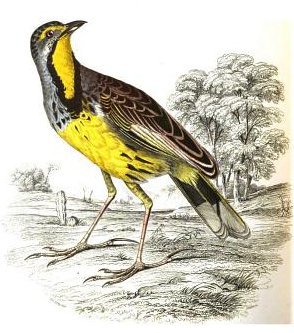
Large word squares are dramatically harder to make than small ones. To date the largest anyone has managed to find are composed of 9-letter words:

Finding a perfect 10×10 word square has been a central goal for wordplay fans for more than 100 years. The task was looking impossible when in 1972 Dmitri Borgmann found an unexpected resource in the African journal of David Livingstone, whose entry for Sept. 26, 1872, reads:
Through forest, along the side of a sedgy valley. Cross its head-water, which has rust of iron in it, then west and by south. The forest has very many tsetse. Zebras calling loudly, and Senegal long claw in our camp at dawn, with its cry, ‘O-o-o-o-o-o-o-o-o-o.’
This is exactly what was needed. Given a pen, the yellow-bellied longclaw, Macronyx flavigaster, could have drawn for Livingstone a perfect 10×10 word square:
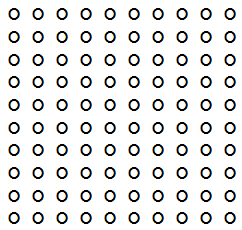
We ought to consult other species more often. Any longclaw could have given us this contribution — indeed, this is the only word square the bird is capable of making!
Back from the Klondike
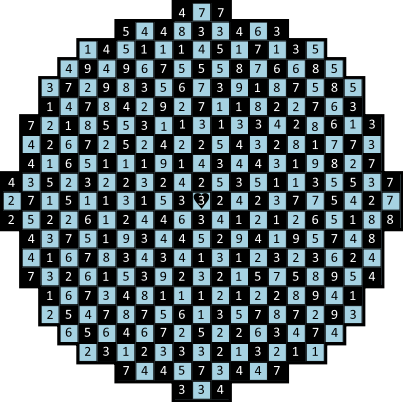
Sam Loyd devised this puzzle in 1898. Begin at the heart in the center and move three squares in any of the eight directions, north, south, east, west, northeast, northwest, southeast, or southwest. You’ll land on a number; take this as the length of your next “march,” which again can go in any of the eight directions. “Continue on in this manner until you come upon a square with a number which will carry you just one step beyond the border, thus solving the puzzle.”
Interestingly, Loyd devised this puzzle expressly to defeat Leonhard Euler’s method of solving mazes. “Euler, the great mathematician, discovered a rule for solving all manner of maze puzzles, which, as all good puzzlists know, depends chiefly upon working backwards. This puzzle, however, was built purposely to defeat Euler’s rule and out of many attempts is probably the only one which thwarts his method.” The original puzzle, as published in the New York Journal and Advertiser, contained a flaw that permitted multiple solutions. That’s been corrected here — there’s only one way out.
Unquote
“I don’t believe in playing down to children, either in life or in motion pictures. I didn’t treat my own youngsters like fragile flowers, and I think no parent should. Children are people, and they should have to reach to learn about things, to understand things, just as adults have to reach if they want to grow in mental stature. Life is composed of lights and shadows, and we would be untruthful, insincere, and saccharine if we tried to pretend there were no shadows. Most things are good, and they are the strongest things; but there are evil things too, and you are not doing a child a favor by trying to shield him from reality. The important thing is to teach a child that good can always triumph over evil, and that is what our pictures attempt to do.” — Walt Disney

